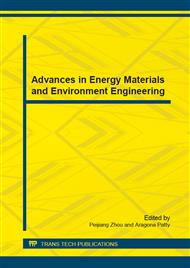p.24
p.28
p.33
p.37
p.42
p.47
p.53
p.61
p.67
Study on the Liquefaction Technology of Corn Stalk-Biomass Materials
Abstract:
Corn straw was used as the main raw material, rice husk, peanut shell and sawdust were used as auxiliary materials; First using qualitative analysis method determined the samples of moisture, ash content, volatile matter, calorific value and the content of cellulose, hemicellulose lignin. Secondly in sulfuric acid as catalyst, ethylene glycol as liquefied agent, ethanol as auxiliary liquefied conditions, corn straw is liquefied. On this basis, single factor experiment was used to investigate the effects of reaction time, reaction temperature, catalyst dosage and liquefied agent on the liquefaction reaction. The experiment results show that reaction temperature is 250°C, reaction time is 2h, dosage of sulfuric acid is 2.9%, the liquefaction rate is 80%. And infrared spectrum analysis of liquefied products and scraps show that lignin, cellulose and hemicellulose have been broken down into different components, and two liquefaction are joined at the same time, the corn straw happen two different reactions.
Info:
Periodical:
Pages:
42-46
Citation:
Online since:
December 2014
Authors:
Keywords:
Price:
Сopyright:
© 2015 Trans Tech Publications Ltd. All Rights Reserved
Share:
Citation:


